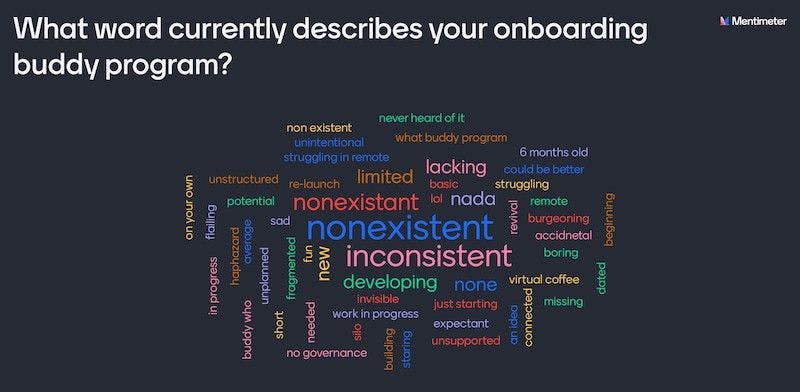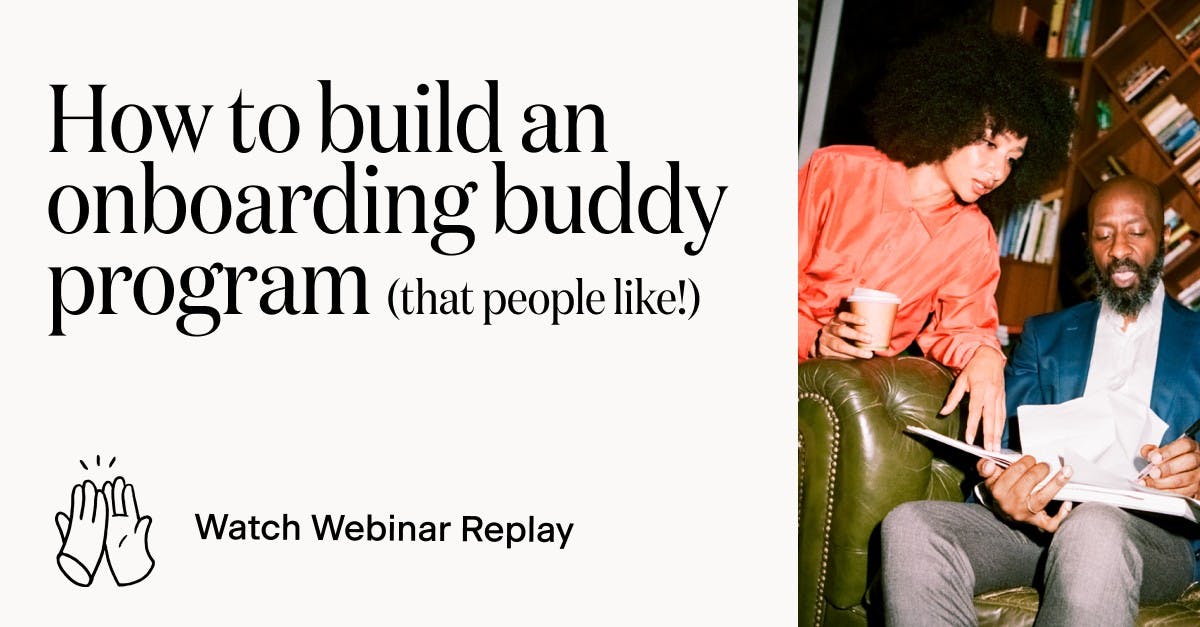
15 questions about building an onboarding buddy program - answered!
"Non-existent," "Inconsistent," "Developing," "Limited," - these are some of the ways participants of our Onboarding Buddy Webinar described their current onboarding buddy programs.

Written by
Stacey Nordwall, People and Product

As more companies continue with remote or hybrid work structures, finding creative ways to support and get new hires up to speed remains a priority. Onboarding buddy programs pair an existing employee with a new hire for the duration of the new hire’s onboarding process. Onboarding buddies help acclimate the new hire to the organization and point them in the right direction when they have questions.
We have a great resource on how to build an onboarding buddy program that doesn’t suck that covers the benefits of an onboarding buddy program, defining an onboarding buddy (and their responsibilities) and four steps to creating a successful onboarding buddy program (including our downloadable Onboarding Buddy Program Overview containing buddy responsibilities, guidelines, is/is not table, and program feedback).
During the webinar, we had many great questions from participants and weren’t able to get to them all. So, for those looking for even more detail on getting the best onboarding buddy program off the ground, this article is for you.
We’ve provided categories for the questions below so you can find what you need quickly.
Jump on in!

Building excitement for your buddy program
Q: What are some tips you recommend to encourage current employees to be a part of the buddy program? How do you get people excited about being a buddy?
Advertise your buddy program as a leadership opportunity. It offers buddies a chance to gain experience as a coach and guide, and the opportunity to build a network within the company. These are both pretty fundamental skills to being an effective people manager.
Also, if you want to make it a little extra special, you could give swag or an incentive like a special lunch. Think about what kinds of things are valuable to your employees and then help to facilitate that connection.
It’s also helpful to think about your HR programs like a product. Any product requires a little bit of marketing and advertising. This could mean things like: giving your program a fun name, creating a flyer or intranet page that details the benefits of the program, or getting testimonials from people who have participated.
Here are a few ideas:
- New hires are future buddies. At the end of the onboarding buddy program, ask the new hire if they would be willing to act as future buddies. You want to give them time to acclimate to the organization, but this helps you build up your future buddy pipeline.
- Make it part of your leadership development program. Outline the benefits of participating and present it as a leadership development opportunity.
- Provide an incentive - maybe it’s free lunch, coffee or special swag or participating.
- Market the program - give it a snappy name, create fun ads, get testimonials, and make it something that people want to participate in.
Some of the attendees offered some options here and pointed out that what you call a buddy can be derived from what your company does or from an aspect of company culture. One attendee said that at a real estate company, they advocated for calling their buddies "neighbors." At Culture Amp, employees are called Campers, so a buddy was naturally a "Camp Guide." It may be a little cheesy, but what's so wrong with a little cheesiness from time to time?
Guidance for buddies
Firstly, identifying a good onboarding buddy doesn't have to be something that the People Team fully owns, get your managers involved in the process. If you give your managers the guidelines - this is someone who should live the company values, should be a top performer, who has an understanding of the person's role or how the role fits into the company - then the manager should be able to help pick the buddy.
Having the manager involved allows them to have a conversation with the buddy about how they can make room for that responsibility. If being a buddy is presented as an opportunity for leadership and developing skills, it helps people view it as an opportunity for growth as opposed to a burdensome task.
Q: Do you recommend specific topics buddies cover w/ their mentees? Do you recommend having onboarding buddy training?
It’s good to have a structure that allows for flexibility. As you are building out your program, including the responsibilities and expectations of the buddy, it doesn't hurt to also include a variety of topics that the buddy could cover in their meetings. For example, maybe you'd like the buddy to show the new hire around the office or share a story about how the company values resonate for them.
It gives the buddy a place to start or something to talk about as an icebreaker when they meet, but it should allow the buddy the flexibility to cover the topics that are most pertinent to the new hire in the course of their onboarding experience.
As for buddy training, unless your buddy program requires the buddy to cover specific topics in a particular way, providing them with the program guidelines and responsibilities would be sufficient.
Q: What are the stats around how many times new hires should meet with their buddies?
In the webinar I referenced stats from research done by Microsoft when they piloted their buddy program. Their research showed that 73% of new hires who met with their buddies at least twice in their first 90 days believed their buddies helped them to quickly ramp up in their role. Meeting at least four times increased that number to 86%. Their research also found that having a buddy led to a 36% increase in satisfaction with their onboarding experience.
You can read more about their study here: https://hbr.org/2019/06/every-new-employee-needs-an-onboarding-buddy
Q: Do you have a sample "onboarding buddy job description" you could share?
Yes! Head over to my blog post here that includes an overview of the buddy's responsibilities.
We have put together a downloadable guide that outlines buddy responsibilities, program guidelines, what a buddy is and is not, and some questions to ask to get feedback on your program.
Q: How do you remove a buddy who is not performing when they volunteered to be a buddy?
Start with a conversation. Maybe the buddy really wanted to participate in the program, but is overcommitted at work or has things going on in their life that doesn’t allow them to be fully engaged. Perhaps their manager can make more room in their workload for them to participate in the program. Or, they might welcome the opportunity from their manager to step down from onboarding buddy duties without feeling they’ve let someone down or won’t get the opportunity again.
Logistics of an onboarding buddy program
Q: How do you set a buddy program when your employees work remotely?
If your team is not all co-located or hasn’t been over the last couple of years, you're already working across boundaries, and over Slack and Zoom to create connections. These same tools make it possible to facilitate a buddy program with remote employees. Provide the buddy with the guidelines and resources available to them, along with some suggestions on how to be a virtual buddy. For example, coffee and lunch can be done virtually over video and food could be ordered in courtesy of the company. If folks want to step away from their desks, they can always call into a meeting link while they venture around their neighborhood.
Tailor your program to whatever the experience is - whether that's co-located, distributed, hybrid, or fully remote.
Q: Do you match up buddies 1:1 with new hires? Or 1 buddy for a group of 5 new hires for example?
A: Mostly what I have seen is 1:1 matching, but this could be an opportunity to try things out. Perhaps a one-to-many buddy to new hire ratio could work.
Plenty of companies use cohort models for onboarding because it helps connect new hires to each other and makes your onboarding program more scalable. Perhaps assigning a few buddies to a cohort would work as well? I think the main thing here would be to make sure that the buddy is given the time needed to act as a resource to multiple folks at the same time.
As Joris Luijke, Pyn’s CEO and Cofounder explains, “In many companies - there are always folks who get picked a lot to buddy up with, often because they are networked, social, strong performers, etc. This puts a lot of stress on this group so you need to find a way to spread the load evenly across the team.”
Systems like Pyn can help with this problem. Pyn sends managers a Slack message asking them to nominate a buddy for an upcoming hire. If the employee they select has already been an onboarding buddy in the past few months, the manager will get a notification letting them know. Below is an example of what this message looks like in Slack.

Q: Do you recommend having buddies be in the same department or cross departmental?
Generally, having a buddy in the same department is easiest to manage and can help facilitate someone getting ramped up into their role more quickly. However, depending on the nature of the role and how big the departments are, a cross-departmental match can also work well. For example, if you have a new hire in Finance, a buddy in HR could be a great match. These are departments that often work together so a buddy match here could help build a new hire’s network with someone they’ll collaborate with in the future.
Basically, you shouldn’t be afraid to try things out and see what best works for your company.
Q: When implementing a hybrid program are you matching remote employees with remote employees + in office with in office or mix up remote and in office employees?
I recommend thinking more about their roles and on how they may work together as opposed to whether they work in an office or remotely. For example, matching remote new hires with remote buddies offers an opportunity to get real first-hand tips about how to navigate being a remote employee in a hybrid environment. That can be great to help create connections and learn how to navigate the organization remotely, however, if the buddy isn’t also in the same role or department, the new hire may miss out on some important context about their role.
Also, you want to be careful not to inadvertently enforce some kind of hierarchy or differential experience where in-office pairings appear more beneficial or get more resources than remote pairings.
I see this as an opportunity to experiment and gather feedback. Test out different pairings and see what feedback you get!
Q: How long should an onboarding buddy program last? What’s the ideal length of time for a buddy program?
I've seen a lot of variation here - anything from 2 weeks to 90 days. I think this is another area where you can try something out, get feedback, and iterate as needed. You can match the duration of your overall onboarding program, or be shorter or longer.
Most likely, in the case of longer buddy programs, the buddy will connect with the new hire more frequently early on and then taper off their meetings after the first month.
Q: We are a very lean team - only 15 employees - will an onboarding buddy program work for us?
If you are planning to grow your team rapidly at this stage, it could be hard to support an onboarding buddy program at the beginning because your available buddy pool is likely pretty small. If not, it could be a pretty low lift way for you to create an onboarding experience that really helps new hires get acclimated and feel comfortable in your organization more quickly.
To get you started, we have put together a downloadable guide which you can find here that outlines buddy responsibilities, program guidelines, what a buddy is and is not, and some questions to ask to get feedback on your program.
This is an approach I’d be somewhat hesitant about. First, I think it’s important to be clear about the time requirements you’re asking of a buddy. In what we have seen, the time commitment tends to be about 6-10 hours over the course of a couple of months. If your program requires more than that, you might want to consider scaling it back or being sure to involve managers in the buddy selection process so that they can create the space for participation.
Secondly, providing more buddies means more logistics when it comes to selecting the buddies and more coordination between the buddies. If the buddies have clearly defined roles and responsibilities for what they need to show a new hire, it may work. For example, Buffer uses a two buddy system with clearly defined buddies - a Role Buddy and a Culture Buddy. However, if these aren’t clearly defined, you’ll likely have people duplicating the same information.
At the end of the day, I’m not sure the extra logistics and coordination would end up providing a better experience for the new hire or save much time.

Stacey loves to hike and read. Her goal is to create inclusive workplaces. Before Pyn, she was an early member of Culture Amp’s people team.
